

Wallcovering Trends. Jason VanLue > Essays > Design For People. "In 1847 an Englishman named Sir Henry Cole startled the Council of the Society of Arts by saying, “Of high art in this country there is abundance; of mechanical industry and invention an unparalleled profusion.
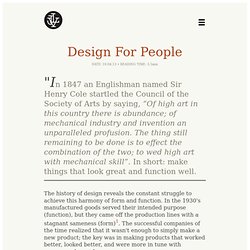
The thing still remaining to be done is to effect the combination of the two; to wed high art with mechanical skill”. In short: make things that look great and function well. The history of design reveals the constant struggle to achieve this harmony of form and function. In the 1930's manufactured goods served their intended purpose (function), but they came off the production lines with a stagnant sameness (form)1. The successful companies of the time realized that it wasn't enough to simply make a new product; the key was in making products that worked better, looked better, and were more in tune with consumer demands. A Brief Rant on the Future of Interaction Design.
So, here's a Vision Of The Future that's popular right now.
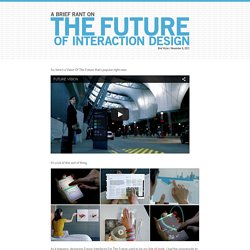
It's a lot of this sort of thing. As it happens, designing Future Interfaces For The Future used to be my line of work. I had the opportunity to design with real working prototypes, not green screens and After Effects, so there certainly are some interactions in the video which I'm a little skeptical of, given that I've actually tried them and the animators presumably haven't.
But that's not my problem with the video. My problem is the opposite, really — this vision, from an interaction perspective, is not visionary. This matters, because visions matter. This little rant isn't going to lay out any grand vision or anything. The 3 Future Waves In Design, And How To Ride Them. As a product designer and a part of frog for nearly 20 years, I have seen our industry change quite a bit.

But what I’ve experienced is nothing compared with the changing landscape I see coming. Our industry will have a choice to make: adapt, or be relegated to decorating the surfaces of the world. Our challenge begins with our history. Product designers have historically been focused on creating the things we can see, feel, and operate. It's still that way today. Twenty years ago, computing was just coming into its own as a medium to which designers could usefully contribute. The Dribbblisation of Design. Only one of these weather apps is attempting to solve the real problem.
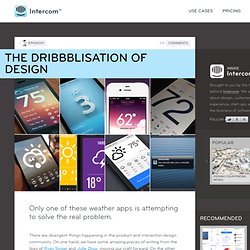
There are divergent things happening in the product and interaction design community. On one hand, we have some amazing pieces of writing from the likes of Ryan Singer and Julie Zhuo, moving our craft forward. The Dribbblisation of Design. Design and the Coming Iceberg. By Mark Rolston - September 9, 2013 I am a product designer.
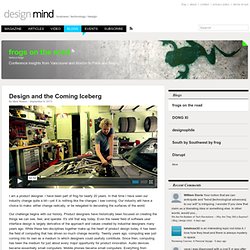
I have been part of frog for nearly 20 years. In that time I have seen our industry change quite a bit—yet it is nothing like the changes I see coming. Our industry will have a choice to make: either change radically, or be relegated to decorating the surfaces of the world. Our challenge begins with our history. The first wave: Experience Design. The modern design challenge is to define a great experience for a consumer that is composed of a range of touch points, in various cases composed of interactions with several devices, retail experiences, personal contact points, software interfaces, physical mechanisms, data, and software intelligence. The second wave: The Iceberg. The third wave: Organic Products.
Why a New Golden Age for UI Design Is Around the Corner. Innovations like this present great challenges for designers.
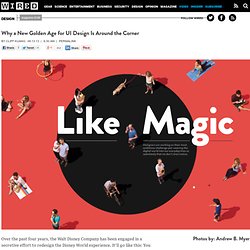
Today’s app and software designers already have a deep understanding of how customers interact with their products. They know down to the pixel where to place a button, how fast a screen should scroll, and how to make an app simple without making it simplistic. But as designers move off of screens and into the larger world, they’ll need to consider every nuance of our everyday activity and understand human behavior every bit as well as novelists or filmmakers. Why Aren't There More Designer Founders? Can You Measure Design's Value? The DMI Conference in Copenhagen sought to explore how to measure design's role in the business world.
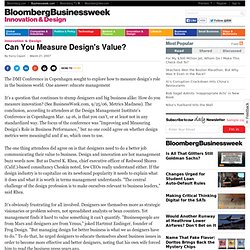
One answer: educate management It's a question that continues to stump designers and big business alike: How do you measure innovation? (See BusinessWeek.com, 9/25/06, Metrics Madness). The conclusion, according to attendees at the Design Management Institute's Conference in Copenhagen Mar. 14-16, is that you can't, or at least not in any standardized way. Naoto Fukasawa & Jane Fulton Suri on Smartphones as Social Cues, Soup as a Metaphor for Design, the Downside of 3D Printing and More. Posted by core jr | 17 Jun 2013 | Comments (0)
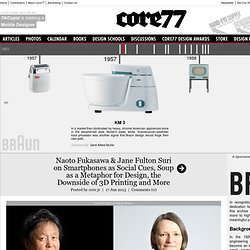
What kind of a designer are you? — Product Design. In the short time since I started designing, I have had a bunch of titles to describe my role; some I chose myself when freelancing, and some were given by the companies that I worked for.

I have been a web designer, a user interface designer, an interaction designer, a user experience designer and most recently, a product designer. As I have moved from one title to the other, the industry has evolved and it is much easier to see some of those patterns in hindsight. What does your role, really encompass when you say you are a designer at a startup, or more importantly what all can it encompass that will help you be better at what you are trying to be? Perspective: Metadesign and designing culture. Two extremely thought provoking pieces of writing found their way to me recently.
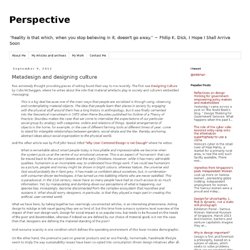
The first was Designing Culture by Colin McSwiggen, where he writes about the role that material artefacts play in society and culture's embedded messaging: This is a big deal because one of the main ways that people are socialized is through using, observing and contemplating material objects. The idea that people learn their places in society by engaging with the physical stuff around them has a long history in anthropology, but it was finally cemented into the theoretical mainstream in 1972 when Pierre Bourdieu published his Outline of a Theory of Practice. Thinking Usability Beyond Simplicity And Can We Really Afford Simplcity? Is Dieter Rams' 10 Principles Of Design Still Applicable Today? Came back from beautiful Thailand speaking at the Design Is Opportunity event. Everyone is thinking about design not only as producing great products but also as a competitive advantage for creating new industries and as comparative advantage for countries.
Met many people who are passionate in design and design thinking.